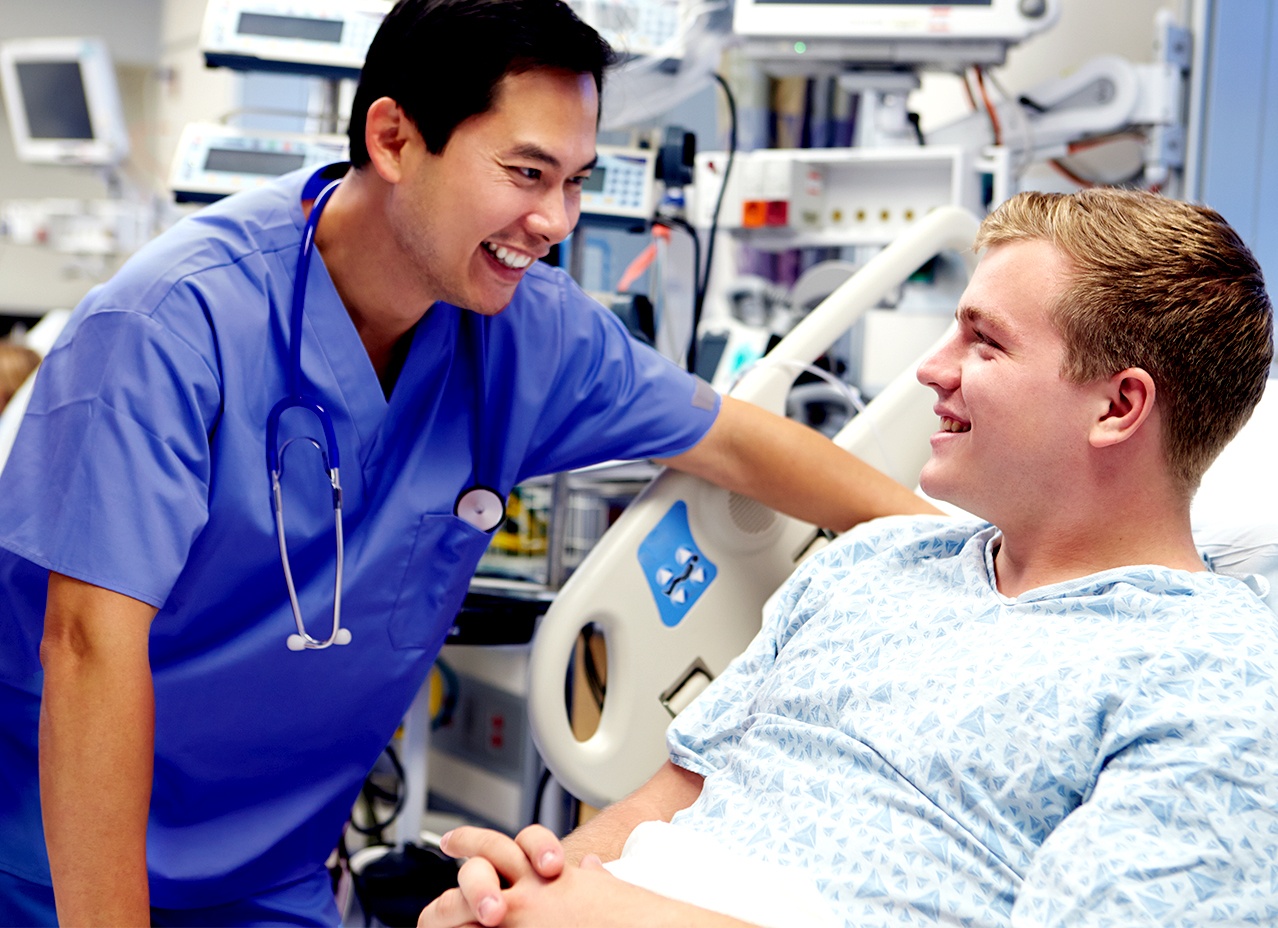Patient Resources
Our physicians and CRNAs are committed to providing you with the best possible care before, during, and after your procedure.


-

Best in Patient Care
Our collaborative care team model allows us to provide the best possible experience for our patients. We have an outstanding team of physician anesthesiologists and Certified Registered Nurse Anesthetists (CRNAs) who will be with you during your entire surgery and in the recovery room. Our innovative approach to patient care allows us to reduce pain, helps decrease hospital time, and most importantly, improves patient outcomes.
What to Expect
You will receive instructions from the hospital or surgery center and from your surgeon about preparing for your procedure, including what medications you can take and what you may eat or drink beforehand. Some patients will be scheduled for pre-admission testing and evaluation prior to the date of surgery. You may or may not meet with an anesthesiologist at this time to discuss your anesthesia care plan. Other patients may not need to have a preoperative visit, and may have a consultation with the anesthesiologist on the day of the procedure.
All patients will meet their anesthesia care team prior to surgery to review the anesthesia plan, address any questions or concerns, and provide consent. If you would like to speak with an anesthesiologist regarding an upcoming procedure, please contact us.
We use a care team model to provide the best possible experience for our patients. An anesthesiologist and/or a certified registered nurse anesthetist (CRNA) will be present at all times throughout your procedure to ensure your safety and comfort.
Once the surgery is complete, you will be moved to the recovery room for continued monitoring and pain management as the anesthetic wears off. Your anesthesia care team will ensure you are comfortable and stable prior to being discharged home (for outpatients) or to your hospital bed (inpatients).
FAQs
There are multiple types of anesthesia that offer a range of effects. The lightest type of anesthesia is called MAC (Monitored Anesthesia Care), and is given for minor procedures like cataract surgery. This includes a light sedative and perhaps a little narcotic, administered through an IV, to keep patients comfortable, but responsive for certain procedures.
Twilight sleep is given for procedures that do not require a breathing tube - including, but not limited to: colonoscopy and upper endoscopy, many hand and foot surgeries, breast biopsy and hysteroscopy. Propofol is usually administered along with a sedative and pain medicine through an IV. This is a very safe and comfortable anesthetic that causes very little “hangover” feeling. People often say it is the best sleep ever.
Regional anesthesia is a type of anesthetic that numbs a portion of the body (a “region”). Examples include spinal for a hip or knee surgery, epidural for childbirth or cesarean and peripheral nerve blocks that numb arms, shoulders, legs and feet. These anesthetics have a number of benefits, including decreased risk of nausea and vomiting, and decreased need for narcotics. They can also provide longer lasting post operative pain relief. Regional anesthetics are usually administered with sedation or Propofol to minimize awareness and anxiety.
General anesthesia is necessary for certain major and minor procedures, including laparoscopy, appendectomy, robotic surgery, larger specialized surgeries like head and neck, and most plastic surgeries. This requires a breathing tube, almost always placed while asleep, and usually the administration of anesthesia gas. Occasionally TIVA (Total IV Anesthesia) can be given rather than anesthesia gas. Sedatives are given prior to induction of general anesthesia and pain and antiemetics are given during the procedure.
During all anesthetics, we closely monitor vital signs including blood oxygen and CO2 content, continuous ECG, blood pressure, and temperature. We occasionally monitor brain waves to assure proper anesthetic depth.
The type of anesthesia you receive will depend on the type of surgery or procedure being performed and your medical history. Your anesthesiologist will help you decide which technique is best for you. You can learn more about different types of anesthesia techniques in the Services section of our site.
During some procedures it is possible to be awake. Good examples include some orthopedic procedures, like knee or hip replacement or hand or foot surgery. It is routine for women to have a Cesarean section with a regional anesthetic and be awake for the birth of their baby. Unfortunately, many surgeries require a patient to be asleep. We are happy to discuss all options and design a plan that works for each person.
We have a highly trained team to reduce pain and discomfort as much as possible. We often can give local anesthetic to numb the operative site for hours after surgery. We are working closely with surgeons to maximize our use of non-narcotic medications before and after surgery and add narcotics only as needed. Please ask your anesthesiologist about a post-operative pain plan.
This depends on the type and length of surgery, as well as the age and medical condition of the patient. Most anesthetics are potent, but short acting and often patients are awake within an hour. Anesthesia can take longer to metabolize, and some patients will be groggy, mildly sedated, or even euphoric for a day after surgery. Narcotics are designed to be longer acting and can contribute to all these effects.
Our anesthesiologists are eager to design an anesthetic plan that limits the amount of narcotics needed. Ask your doctor if regional nerve blocks or preemptive analgesia can be used.
There is a very rare complication of being awake or aware under general anesthesia. According to the American Society of Anesthesiologists, the risk is about 1 in 1,000 general anesthetics. This is different than remembering something during twilight or MAC anesthesia. Also, dreaming can occur under anesthesia and may be remembered later. Awareness under general anesthesia is more common during emergency surgery like an emergent cesarean section or motor vehicle accident. Sometimes pre-existing medical conditions can preclude an especially deep anesthetic, but we are happy to work with our patients and surgeons to design a safe and comfortable anesthetic plan. We also have available a Bispectral Index (BIS) monitor that monitors brain wave activity to help assure the anesthesia depth is adequate.
The American Society of Anesthesiologists state that patients can eat a full meal up to 8 hours prior to their surgery. A light meal (dry toast, coffee or tea with sugar) that avoids fatty foods can be eaten 6 hours prior to surgery. Clear liquids can be consumed up to 2 hours before surgery. Clear liquids include water, tea or coffee without cream, Gatorade or clear juice.
A patient’s medical condition or specific procedure may change these guidelines.Please follow your personalized preoperative instructions.
Please read your preoperative instructions carefully. We usually ask patients to stop taking all blood thinners prior to surgery (Aspirin, Plavix, Eliquis etc) and to avoid NSAIDS (Ibuprofen, Naproxen) as they may increase the risk of bleeding. Other medications to avoid include oral diabetes medications and combined blood pressure medications with a diuretic like Hydrochlorothiazide. You may be asked to hold your Lasix.
Most medications prescribed by your doctor can be taken with clear fluids. Please check with your physician about which medications to take before surgery.
Insulin may be continued at a lower dose if necessary. Ask your personal doctor what she recommends for insulin dose before surgery. Insulin pumps are often continued at a reduced basal rate.
Please avoid all herbal supplements for a week or two before surgery.
It is important to have all health problems addressed and under control. Please take all medications directed by your doctor prior to your procedure. Avoid the medications listed above.
It is also important to avoid smoking as much as possible before the surgery, including marijuana and vaping. Please avoid any herbal supplements, weight loss medications, unprescribed or illegal medications.
For patients on narcotics before their surgery (Percocet, Vicodin, Fentanyl, Ultram) it is helpful to have a plan with your surgeon. When scheduling your surgery, please let your team know what pain medications you take regularly and discuss a plan for post-op pain.
Bring a list of your medications to surgery. Please leave all valuables at home.
If you have obstructive sleep apnea, it can be helpful to bring your CPAP machine with you.
Nausea and vomiting are very common side effects of anesthesia. We give our at risk patients at least one medication to prevent post-op nausea and vomiting. Patients at increased risk depending on age, sex, medical history, and specific surgery will receive two or more antiemetics. Please let your care team know if you have a history of post op nausea and vomiting.
Anesthesia can be either personally performed by an anesthesiologist or medically directed. In many cases, the care team model provides the best possible experience for our patients. We have an excellent team of certified registered nurse anesthetists (CRNAs) who will be with you during your entire surgery. The physician anesthesiologists supervise the CRNAs and will be present for all critical events. The anesthesiologists are also immediately available throughout your procedure and in the recovery room if needed for any reason.
A CRNA (Certified Registered Nurse Anesthetist) is an advanced practice nurse who is trained in the field of anesthesia. To become a CRNA, individuals complete a Master’s of Science in Nursing program focused on anesthesia, complete extensive clinical training and pass a certification exam approved by the National Board of Certification and Recertification of Nurse Anesthetists. Several years of critical care experience is required prior to entering a nurse anesthesia program.
At SHAC, CRNAs are valued members of the anesthesia care team who deliver anesthesia under the medical direction of a physician anesthesiologist. They are highly skilled in administering all anesthesia types and work alongside all members of the perioperative team to oversee the patient’s safety and wellbeing before, during and after anesthesia care.
For many surgical procedures a breathing tube is introduced through the vocal cords and into the windpipe to help you breath while under general anesthesia. This usually occurs after you are asleep with little difficulty. Rarely, the anesthesia provider may experience difficulty inserting the tube. Our anesthesia care providers are trained to manage this issue and mitigate the risk to the patient.
An alternative form of airway management or different anesthesia type may be used to ensure your safety and comfort during the procedure. Your anesthesia provider will inform you of the difficult intubation after the surgery and provide you with documentation so you have the information for other anesthesiologists who may care for you in the future.
Billing
Society Hill Anesthesia Consultants, PC participates with all federal and state insurance products, as well as most of the major commercial carriers. Usually, if the facility and surgeon are participating with your insurance, anesthesia services will be paid. As with any physician service, patients are responsible for their deductibles and co-pays. Keep in mind that every insurance policy is different and it is your responsibility to understand your benefits prior to the date of service.
The majority of our cases are performed by an anesthesiologist and a CRNA working together. Some insurance carriers require that we show the full service charge for both providers when we submit our claim for payment. While it looks like double billing, the amount that is allowed by the carrier is the same as if there were only a single provider.
SHAC bills your insurance for the professional anesthesia fees on behalf of the anesthesiologist/CRNA who took care of you during your surgery. The facility bills your insurance for the technical component of the anesthesia service, which includes the drugs, supplies, and equipment used to put you to sleep.
Depending on your insurance, a referral may be required for the surgeon and facility prior to having a surgical procedure. Usually, the anesthesia services are covered by the facility referral – but insurance requirements vary and it is always best to check with your carrier prior to your scheduled surgery.
If your carrier requires precertification for a surgery or procedure performed, the anesthesia portion of the procedure is usually covered by that pre-certification. Please check with your carrier prior to the date of service, as this may vary, depending on your insurance policy.
The cost of anesthesia depends on the type of surgical procedure and length of the surgery. For patients with insurance, please check with your carrier prior to surgery to understand your benefits coverage. We will submit a claim to your insurance and send you a bill if there is a co-pay or deductible. For patients with no insurance or for patients undergoing a procedure that is not covered by insurance, please contact our billing department to receive a quote for anesthesia.
Some insurance carriers do not cover anesthesia for certain procedures, without proof of medical necessity. This is becoming more common with some pain procedures and gastrointestinal (GI) procedures.
While we do our best to provide the required documentation to the carrier, sometimes the claim is denied as a non-covered service. For this reason, patients who desire to be put to sleep for these procedures are asked to sign an Advanced Beneficiary Notice (ABN) to accept financial responsibility. The cost will be presented to you up front, and we will always try to collect payment from your insurance prior to sending you a bill.
Professional anesthesia billing for Society Hill Anesthesia Consultants is provided by Coronis Health. They may communicate through text messages. These text messages are legitimate.
Patient Education
Enhanced Recovery after Surgery (ERAS) is a collaborative program between surgery, anesthesia and nursing to aid recovery postoperatively. Most elective procedures can be designated ERAS and will then follow a protocol that has three components. First, the surgeon will choose the least invasive procedure and may ask you to see a nutritionist or physical therapist preoperatively so that you start the surgical process as healthy as possible. You may be advised to quit smoking.
Next, on the day of surgery the surgeon may ask you to drink a Gatorade before coming to the hospital. This can help prevent dehydration and post op nausea. Upon admission, medications like tylenol and gabapentin are often given by mouth to decrease postoperative pain. The anesthesiologist will administer antiemetics preemptively and will choose shorter-acting though still potent anesthetics. If possible, a nerve block may be offered to numb the operative site before surgery to limit post op pain and narcotic use.
In the recovery room, nursing staff will encourage early eating and ambulation. Even after joint replacement surgery, our nursing staff will help you get out of bed on the day of surgery. Cardiac patients are often extubated in the operating room rather than spending hours or days on a respirator in the ICU. Non-narcotic pain relievers are given around the clock with narcotics only offered when needed.
Our ERAS program varies with different surgical services but is designed overall to reduce pain, decrease hospital and most importantly to get our patients back to normal, as soon as possible.


